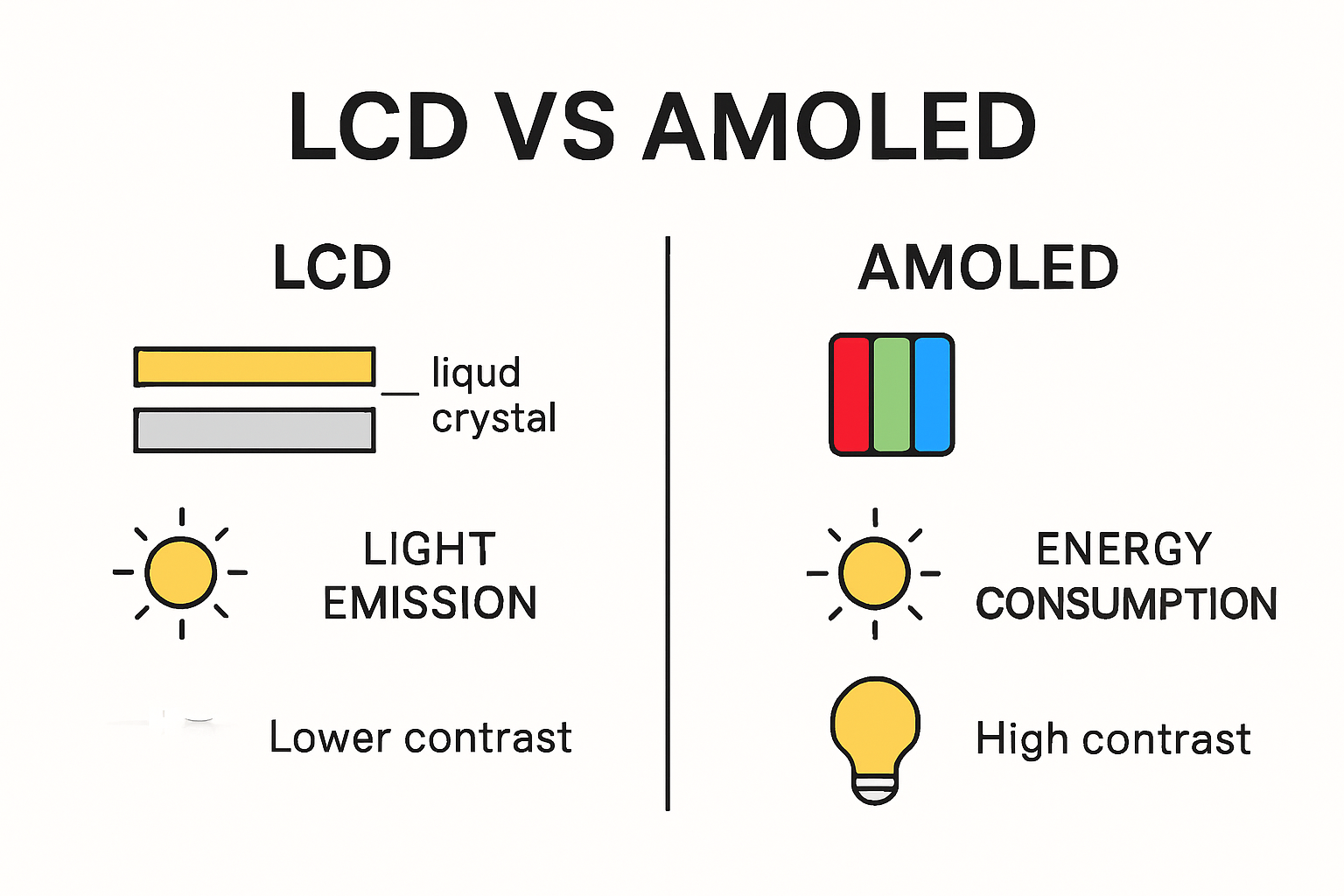
Everyone wants screens that look sharper, brighter and just work better. Here’s something wild though. AMOLED displays can save up to 72.49% more energy than traditional LCDs. Most people will tell you AMOLED is the winner, hands down. The real surprise is that in tough conditions, old-school LCDs often outlast and outperform the new tech.
Table of Contents
- How Lcd And Amoled Technologies Work
- Visual Quality: Brightness And Colour Comparison
- Durability And Performance In Demanding Environments
- Choosing Between Lcd And Amoled For Your Application
Quick Summary
| Takeaway | Explanation |
|---|---|
| Energy Efficiency | AMOLED displays excel in energy efficiency, especially with darker content, potentially offering up to 72.49% savings compared to traditional LCDs. |
| Visual Quality | AMOLED screens provide superior color reproduction and contrast, making them ideal for industries like graphic design and video production, while LCDs offer consistent color accuracy. |
| Environmental Resilience | LCDs perform better in extreme temperatures and are more resistant to image retention, making them suitable for demanding industrial applications. |
| Cost Considerations | LCDs are generally more cost-effective with longer potential lifespans, while AMOLEDs may involve higher upfront costs but offer superior visual quality. |
| Application Suitability | The choice between LCD and AMOLED should be based on specific operational needs, such as environment, energy consumption, and required visual performance. |
How LCD and AMOLED Technologies Work
Understanding the fundamental mechanics of display technologies reveals the fascinating world of visual reproduction. LCD and AMOLED represent two distinct approaches to creating vivid digital images, each with unique operational principles that impact performance, energy consumption, and visual quality.

The Liquid Crystal Display (LCD) Mechanism
LCD technology functions through a sophisticated layered approach to image generation. Wikipedia research reveals that liquid crystal displays operate by manipulating light transmission through carefully aligned liquid crystal molecules. These microscopic molecules are sandwiched between two transparent electrodes and polarizing filters, creating a complex light modulation system.
When an electric current passes through the liquid crystals, they realign their molecular structure, effectively blocking or allowing light to pass through. This precise control enables the creation of images by selectively modulating light intensity across different pixels. Traditional LCDs require a constant backlight, which means even dark scenes consume significant energy because the backlight remains active.
AMOLED: Active Matrix Organic Light Emitting Diode Technology
Research from scientific publications demonstrates that AMOLED displays represent a revolutionary approach to image generation. Unlike LCD technologies, AMOLED pixels are constructed using organic compounds that directly emit light when electrically stimulated. This fundamental difference allows for remarkable advantages in display performance.
Each pixel in an AMOLED display functions as an independent light-generating unit. When electrical current is applied, organic materials generate light without requiring an external backlight. This self-emissive characteristic enables truly exceptional visual experiences, particularly in rendering deep blacks and high contrast ratios. Comparative research indicates that Dynamic AMOLED displays can achieve up to 72.49% energy savings compared to traditional PLS TFT LCDs, highlighting their technological superiority.
Performance and Energy Efficiency Comparison
The core difference between LCD and AMOLED technologies lies in their light generation and control mechanisms. LCDs rely on external backlighting and molecular light manipulation, while AMOLED displays generate light directly at the pixel level. This fundamental variation translates into significant performance distinctions.
AMOLED displays excel in energy efficiency, particularly when displaying darker content. Since black pixels are essentially turned off rather than blocked by a backlight, these displays consume substantially less power during dark scenes. This characteristic makes AMOLED particularly attractive for battery-powered devices like smartphones and tablets.
LCD technologies, while more mature and generally less expensive to manufacture, require consistent backlighting. This means energy consumption remains relatively constant regardless of displayed content, making them less efficient compared to their AMOLED counterparts. However, LCDs often provide more consistent color reproduction and longer potential lifespans, presenting a trade-off between technological approaches.
Understanding these technological nuances helps professionals and tech enthusiasts make informed decisions about display technologies, recognizing that each approach offers unique advantages depending on specific use cases and performance requirements.
To summarise the technology, energy consumption, and basic advantages of each display type, see the table below:
| Feature | LCD | AMOLED |
|---|---|---|
| Light Generation | External backlight through liquid crystals | Each pixel emits its own light (self-emissive) |
| Energy Consumption | Constant regardless of image content | Varies; very efficient with darker images (up to 72.49% savings) |
| Colour Reproduction | Consistent, less vibrant | Highly saturated, vivid, wide colour gamut |
| Cost | Lower, mature manufacturing | Higher, advanced materials and processes |
| Lifespan | Generally longer, less image retention risk | Can degrade faster, risk of burn-in |
| Optimal Application | Industrial, outdoor, static display | Creative, multimedia, controlled environments |
Visual Quality: Brightness and Colour Comparison
Display technology extends beyond mere technical specifications to deliver a visual experience that captivates users across various devices. The comparison between LCD and AMOLED technologies reveals nuanced differences in brightness, color reproduction, and overall visual performance that significantly impact user perception and satisfaction.
Brightness Performance and Luminance Characteristics
Research from display technology studies demonstrates fascinating insights into brightness perception across different display technologies. When participants were asked to adjust AMOLED and LCD screens to achieve perceived equal brightness, remarkable differences emerged. The AMOLED displays achieved comparable visual brightness while maintaining substantially lower actual luminance levels, suggesting remarkable energy efficiency.
Scientific evaluations indicate that LCD screens typically achieve higher luminance values for white screens compared to AMOLED displays. However, AMOLED technologies excel in luminance uniformity, providing more consistent visual distribution across the entire display surface. This characteristic becomes particularly crucial for professionals who require precise and uniform visual representation, such as graphic designers, photographers, and video editors.

Colour Reproduction and Visual Saturation
Colour representation represents another critical battleground between LCD and AMOLED technologies. Comparative studies reveal that AMOLED displays consistently produce more saturated and vivid images. Over half of the research participants expressed a clear preference for AMOLED visual quality, highlighting the technology’s ability to create more engaging and dynamic visual experiences.
AMOLED displays achieve superior colour reproduction by allowing each pixel to generate its own light. This self-emissive characteristic enables deeper blacks, more vibrant colours, and higher contrast ratios. The organic compounds used in AMOLED pixels can generate a wider colour gamut, meaning they can display a more extensive range of colours compared to traditional LCD technologies.
Professional and User Experience Implications
The differences in visual quality between LCD and AMOLED technologies extend beyond mere technical specifications. For professionals in fields like design, photography, and content creation, these variations can significantly impact workflow and creative output. AMOLED displays offer more accurate colour representation and deeper visual contrast, making them particularly attractive for visual professionals who require precise colour management.
Consumer preferences also play a crucial role in display technology selection. The more saturated and vibrant colours of AMOLED displays often create a more immersive viewing experience, particularly for multimedia consumption, gaming, and content streaming. However, LCD technologies continue to offer advantages in specific scenarios, such as consistent colour reproduction and potentially longer display lifespans.
Ultimately, the choice between LCD and AMOLED technologies depends on individual requirements, use cases, and personal preferences. Professionals and tech enthusiasts must weigh factors like colour accuracy, energy efficiency, and visual performance when selecting display technologies for their specific needs.
The following table summarises the differences in visual performance characteristics between LCD and AMOLED displays for professionals and end-users:
| Visual Aspect | LCD Advantage | AMOLED Advantage |
|---|---|---|
| Perceived Brightness | Higher peak brightness (white screens), sunlight visible | Efficient brightness at lower luminance |
| Colour Vibrancy | More natural, less saturated | Highly vivid, striking saturation |
| Colour Uniformity | May suffer from some uniformity issues | Uniform across whole display |
| Contrast/Black Level | Lower, can appear greyish in dark settings | Deep blacks, excellent contrast |
| Burn-In Risk | Minimal | Can suffer from burn-in on static images |
| User Preference | Consistent colour, longer lifespan | Immersive experience, richer visuals |
Durability and Performance in Demanding Environments
Professionals across various industries require display technologies that can withstand challenging environmental conditions. The performance of LCD and AMOLED displays under extreme temperatures, high humidity, and intense operational scenarios becomes crucial for reliability and longevity.
Temperature and Environmental Resilience
Operational environments present unique challenges for display technologies. Industrial display research reveals that LCD technologies demonstrate superior performance in extreme temperature ranges. Traditional LCDs can typically operate between 20°C to 70°C, making them more suitable for industrial applications like construction sites, marine environments, and outdoor surveillance systems.
AMOLED displays, while technologically advanced, show more sensitivity to temperature fluctuations. The organic compounds used in AMOLED pixel construction can degrade more rapidly under sustained extreme temperatures, potentially compromising display performance and lifespan. This vulnerability makes AMOLED less ideal for sectors requiring consistent performance in harsh environmental conditions.
Longevity and Image Retention Challenges
Specialized display technology analysis highlights a critical vulnerability in AMOLED technologies known as burn-in. When static images are displayed for extended periods, AMOLED screens can develop permanent image retention, reducing display quality over time. This characteristic presents significant challenges for professionals who require consistent visual performance in applications like control rooms, monitoring stations, and industrial dashboards.
LCD technologies demonstrate more resistance to image retention. The liquid crystal mechanism allows for more consistent long-term performance, making them preferable for applications requiring continuous display of static content. Professionals in fields such as security monitoring, transportation control, and industrial process management can rely on LCD displays for sustained visual clarity without degradation.
Brightness and Visibility in Challenging Conditions
Visibility remains a critical factor in demanding environments. Comparative studies demonstrate that LCD displays can achieve brightness levels exceeding 800 cd/m², ensuring optimal visibility under direct sunlight and challenging lighting conditions. This characteristic becomes essential for outdoor applications, field work, and industrial settings where display readability directly impacts operational efficiency.
AMOLED technologies, while offering superior colour reproduction, struggle to maintain consistent brightness in high-ambient light scenarios. The organic pixel structure becomes less effective when competing with intense external light sources, potentially compromising visual clarity in outdoor or brightly lit environments.
Professionals must carefully evaluate their specific operational requirements when selecting display technologies. While AMOLED offers exceptional visual quality in controlled environments, LCD technologies provide more robust performance across diverse and challenging conditions. Factors such as temperature resistance, image retention, and visibility under extreme lighting become critical considerations for industries demanding reliable and durable display solutions.
Understanding these nuanced differences enables professionals to make informed decisions, selecting display technologies that align precisely with their operational demands and environmental challenges.
Choosing Between LCD and AMOLED for Your Application
Selecting the appropriate display technology requires a strategic approach that considers multiple factors beyond basic technical specifications. Professionals and businesses must evaluate their specific requirements, operational environments, and performance expectations to make an informed decision between LCD and AMOLED technologies.
Industry-Specific Performance Considerations
Different industries demand unique display characteristics that influence technology selection. Research from power consumption studies demonstrates that AMOLED displays offer significant energy efficiency advantages, particularly in scenarios involving dark content display.
For industrial applications requiring robust performance, LCD technologies often provide more reliable solutions. Construction, marine, and outdoor surveillance sectors benefit from LCDs’ temperature resilience and consistent performance. Security monitoring systems, transportation control centers, and field service equipment typically prioritize durability over advanced visual aesthetics.
Conversely, creative industries like graphic design, video production, and digital media production might prefer AMOLED displays for their superior colour reproduction and higher contrast ratios. The ability to render more vibrant and accurate colours makes AMOLED displays attractive for professionals who require precise visual representation.
Cost and Long-Term Investment Analysis
Budgetary considerations play a crucial role in display technology selection. LCD technologies generally offer more cost-effective solutions with lower manufacturing expenses and longer potential lifespans. Businesses operating with constrained budgets or requiring large-scale display deployments often find LCD technologies more economically viable.
AMOLED displays, while technologically advanced, typically command higher initial investment costs. The sophisticated organic compounds and complex manufacturing processes contribute to elevated pricing. However, the potential energy savings and superior visual performance can offset these initial expenses for organizations prioritizing cutting-edge technology and visual quality.
Operational Environment and Usage Patterns
The specific operational context determines the most suitable display technology. Environments with extreme temperature variations, high humidity, or constant exposure to direct sunlight favor LCD technologies. Their robust construction and consistent performance make them ideal for challenging conditions.
For indoor environments with controlled lighting and less demanding operational requirements, AMOLED displays offer compelling advantages. multimedia consumption, professional content creation, and scenarios requiring exceptional colour accuracy benefit significantly from AMOLED’s advanced visual capabilities.
Professionals must conduct comprehensive evaluations considering factors such as:
- Expected operational lifespan
- Budget constraints
- Environmental conditions
- Specific visual performance requirements
- Energy consumption expectations
Ultimately, no universal solution exists. The choice between LCD and AMOLED technologies depends on nuanced understanding of specific organizational needs, balancing technical performance, financial considerations, and long-term strategic objectives.
By methodically analyzing these multifaceted aspects, businesses and professionals can select display technologies that not only meet immediate requirements but also provide sustainable, future-proof solutions aligned with their unique operational landscape.
Frequently Asked Questions
What is the main difference between LCD and AMOLED displays?
LCD displays use an external backlight and liquid crystals to create images, while AMOLED displays generate light directly from each pixel, allowing for deeper blacks and higher contrast ratios.
Which display technology is more energy-efficient?
AMOLED displays can be significantly more energy-efficient, especially when displaying darker content, saving up to 72.49% more energy compared to traditional LCDs.
Are AMOLED displays more durable than LCDs?
No, LCDs generally have better durability in demanding environments, as they are more resistant to temperature fluctuations and image retention, whereas AMOLED displays can suffer from burn-in and may degrade faster.
For which applications should I choose LCD over AMOLED?
You should choose LCDs for industrial applications, outdoor use, or scenarios requiring consistent color reproduction and longer lifespans, while AMOLEDs are better for creative fields like graphic design or video production.
Ready for Next-Level Displays? Find Devices That Match Your Professional Demands
Are you tired of screens that do not keep up with real-world work? After learning how LCD and AMOLED technologies battle with energy efficiency, durability, and visual clarity, does it feel like your current gear is always a step behind? If you need a smartphone, tablet, or device that works just as well in harsh outdoor environments as it does in the office, it is time to experience technology built for South African businesses. At PMC Jewellery, you will find rugged smartphones with ultra-bright LCD panels for outdoor visibility and premium AMOLED displays for lifelike colours, as well as advanced thermal imaging, secure access systems, and professional-grade gadgets for every sector.

Do not let outdated screens slow you or your team down. Whether you are working in construction, security, or any field that demands results, shop our latest arrivals and see which display fits your industry best. Discover the difference at PMC Jewellery while performance stock lasts.
Recommended
- FNGEEN 4006 Men Trendy Waterproof Quartz Watch(Black Leather Black Ste – PMC Jewellery
- For Samsung Galaxy Watch 5 44mm 20mm Two-color Stripe Silicone Watch B – PMC Jewellery
- For Samsung Galaxy Watch 5 40mm 20mm Two-color Stripe Silicone Watch B – PMC Jewellery
- For Samsung Galaxy Watch 4 Classic 42mm / 46mm 20mm Carbon Fiber Strip – PMC Jewellery
- For Apple Watch 5 & 4 44mm / 3 & 2 & 1 42mm Round Tail Retro Crazy Hor – PMC Jewellery
- Shine in Style with 18K Gold Plated Crystal Heart Pendant Necklace Featuring Purple Stone - Perfect Gift – PMC Jewellery
